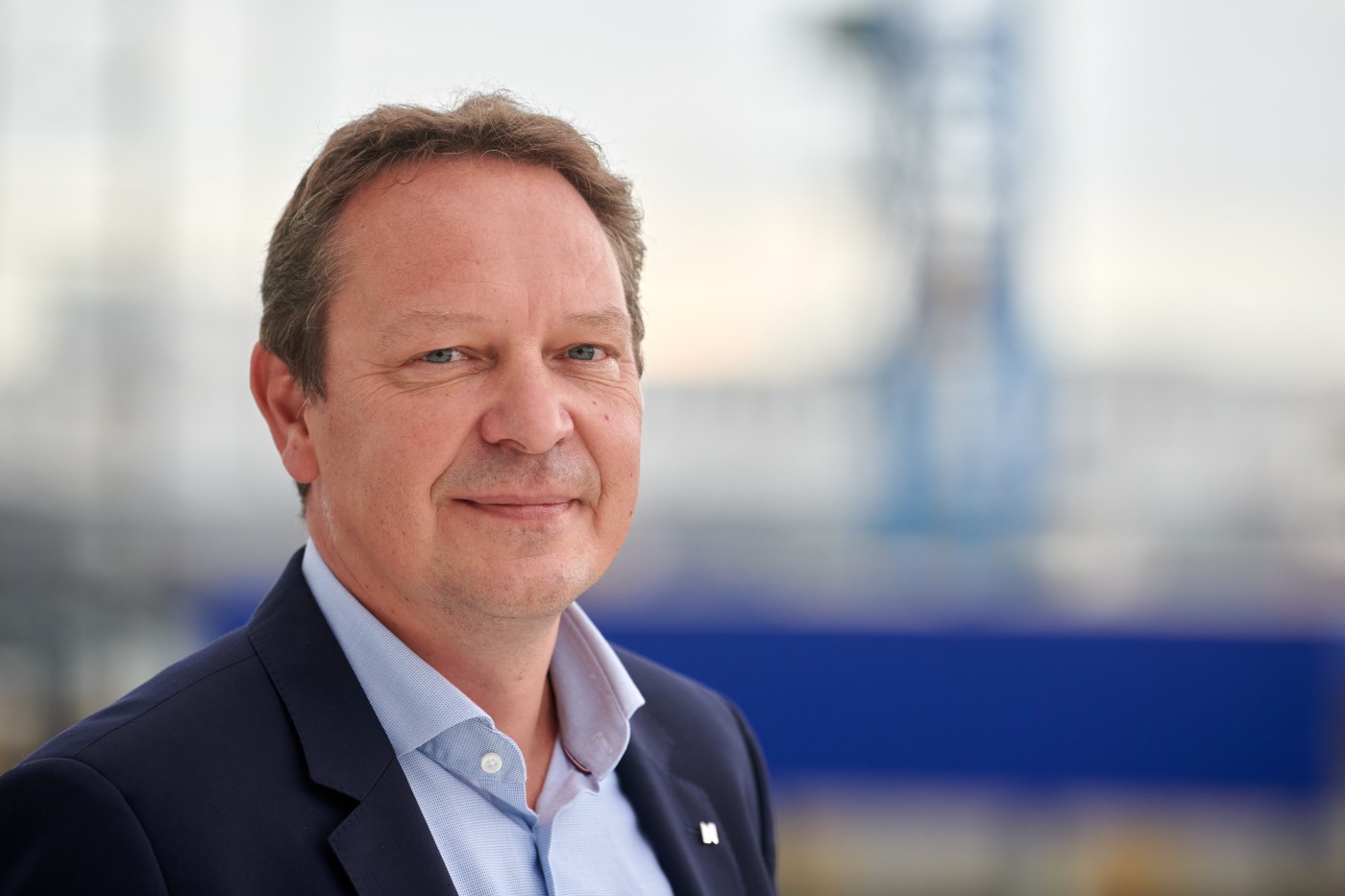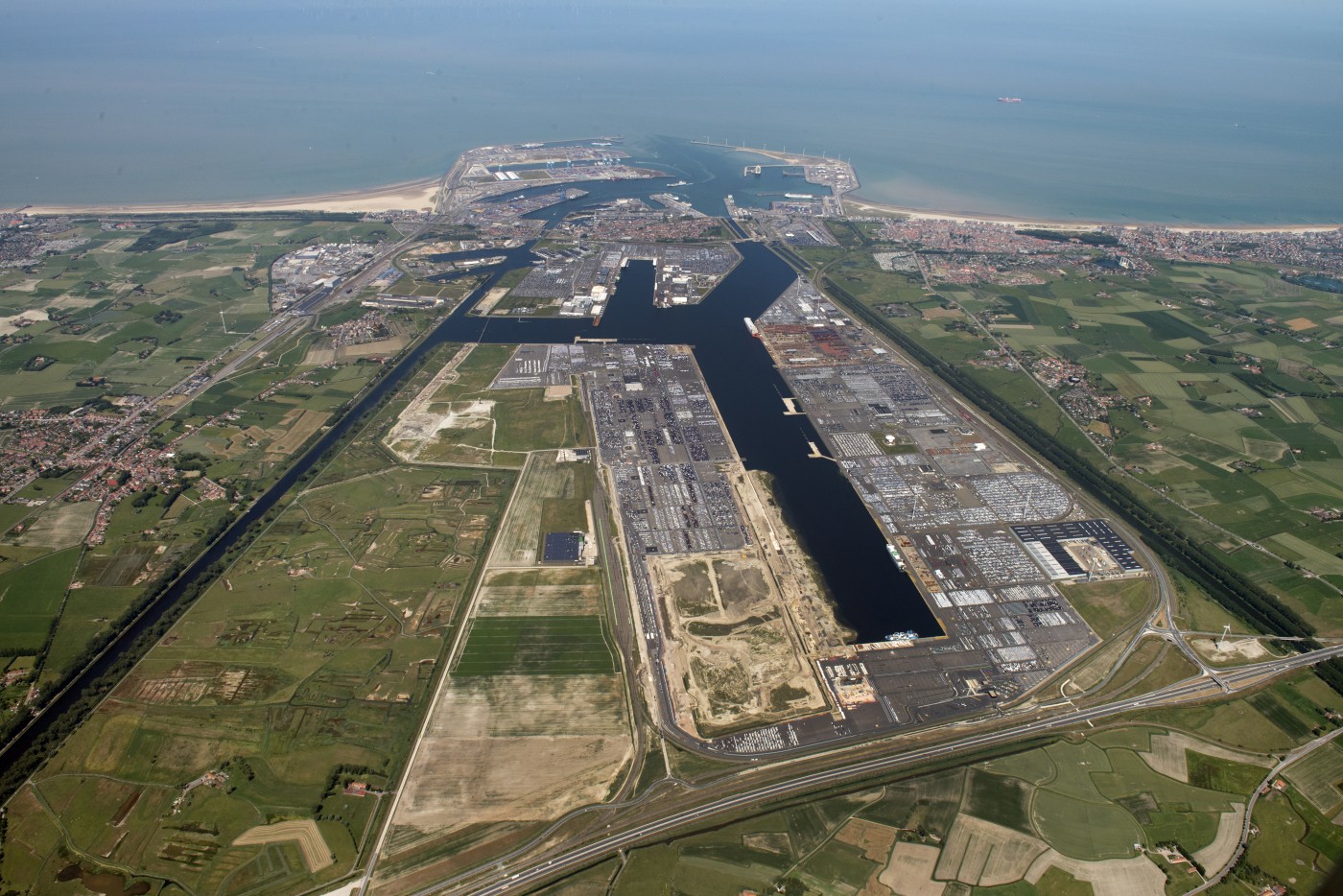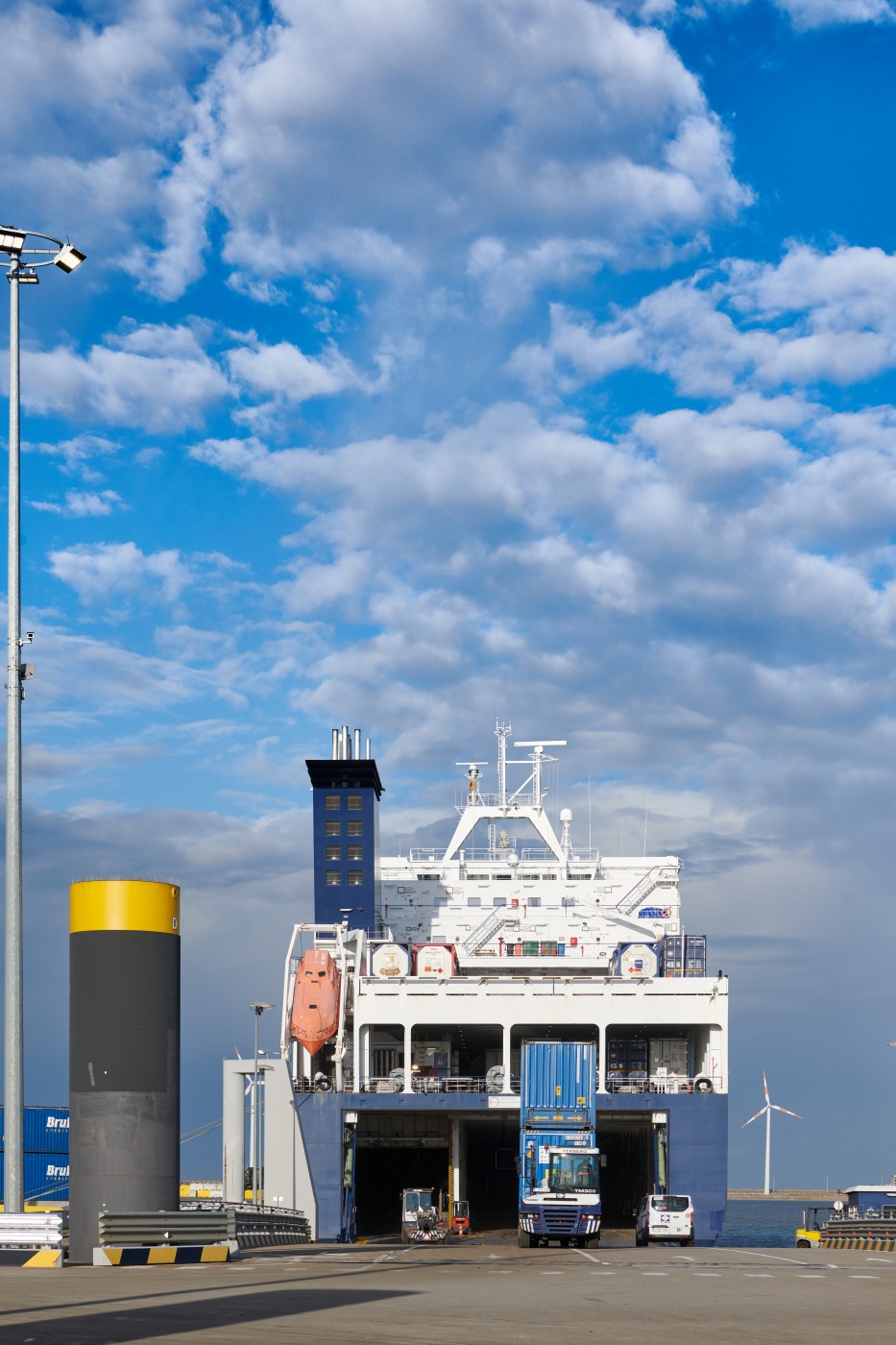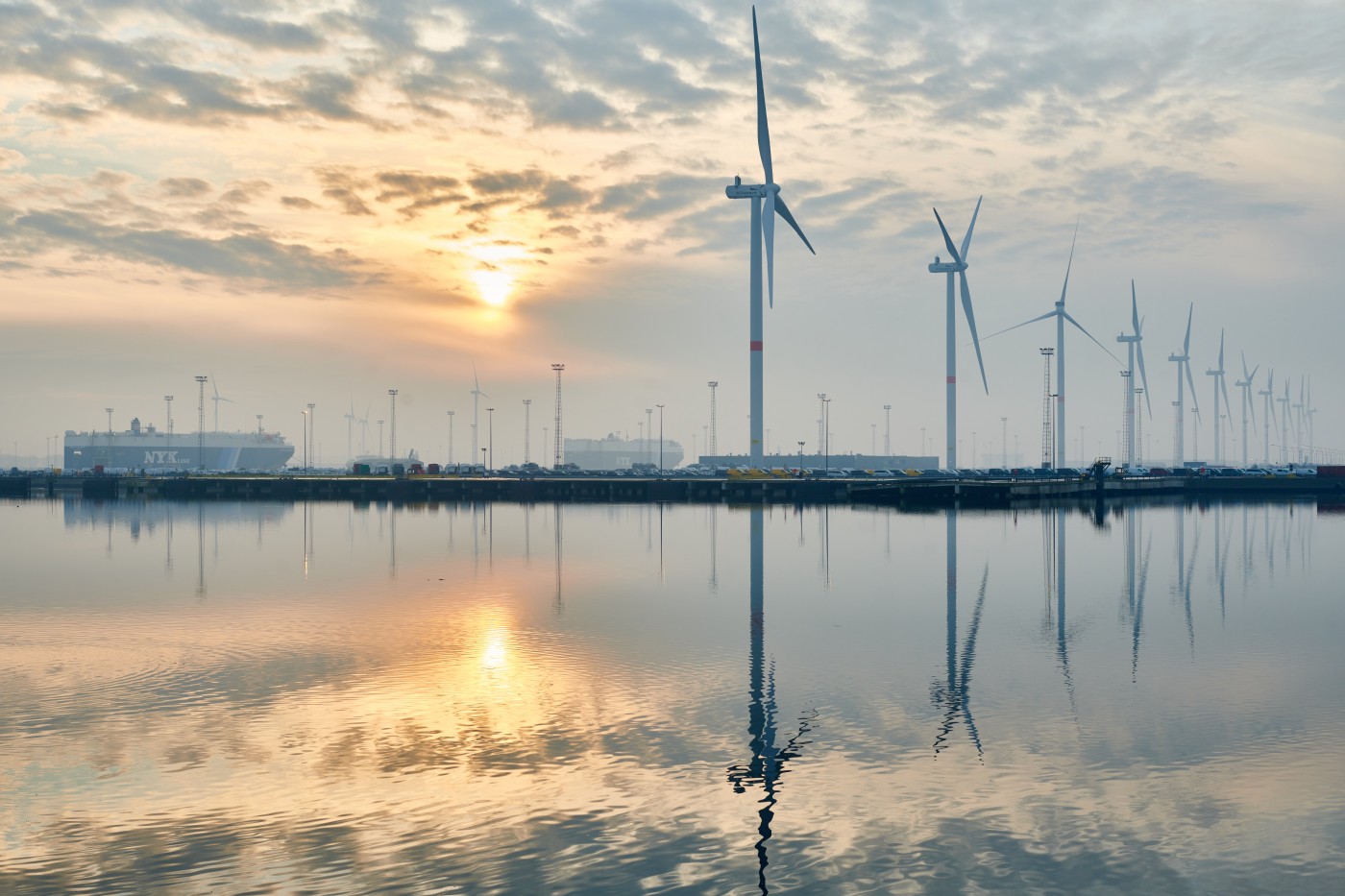29 January 2021
This month, Mr. Tom Hautekiet tells ESPO all about the Port of Zeebrugge! Discover below how Mr. Hautekiet got into the port sector, how the Port of Zeebrugge handled the COVID-19 crisis and Brexit, and learn more about his views on the role of a port managing body and how a port can contribute to the decarbonization of the transport and logistics chain.
 (c) Mike Louagie
(c) Mike Louagie
Can you briefly present the Port of Zeebrugge? What are its main characteristics and challenges?
The port of Zeebrugge is a maritime crossroads shipping nearly 47 million tonnes of goods annually. Our coastal port is one of the world’s foremost roll-on/roll-off ports, a global leader in car-handling and a fully equipped container port thanks to our infrastructure and water depth. Zeebrugge offers intra-European and intercontinental services and is therefore an important access port to the European markets. One of our challenges in the year to come is to limit the consequences of Brexit and create opportunities in this new era of trade between the UK and mainland Europe. In addition, the Covid-19 pandemic is a challenge on many levels globally, including ports and logistics. We hope that 2021 will bring stability after the disruption of the economic climate. Especially the gradual recovery of the automotive sector is an important aspect for the port of Zeebrugge.
 (c) Henderyckx
(c) Henderyckx
You have been leading the Port of Zeebrugge since October last year. Prior to taking up this position, you worked for Bekaert, a Belgian multinational company. Why did you decide to move to the port sector? Was it challenging to get acquainted with the sector?
I quickly realised that the job in the Port of Zeebrugge differed from the one I had in terms of industry, company ownership, short and long term targets, stakeholder value versus shareholder value, ... In other words, I saw aspects where I could develop and strengthen myself as a person. Aside from those differences, there are many similarities to what I’ve done before; there’s the commercial importance and the international character and contacts, for example. Building on these strengths with sufficient room to explore and learn is what convinced me to make the change.
The biggest challenge for myself is to be a facilitator in the middle of a chain. I’ve been trained to explore and develop new businesses, to talk directly to end users and skip as many people in the value chain as possible. Now, being in the middle, I realise I need to go step by step, but still I’m convinced that ports can and should be much more proactive in deciding which type of business they are looking for, what fits in their long term plan and where they can make the difference compared to others.
What is your view on the role of a port managing body? Do you see an active role for a port managing body, for instance in terms of setting out a strategy to attract new trades and business in the port, or do you see the port managing body more as a facilitator of trade?
The port authority is responsible for the technical, nautical and commercial aspects of the port management, all in good relationship with our stakeholders. Regarding trade and business, I believe we can do more. Today we act as a facilitator for trade, but I believe we can play an even more active role in attracting new trade and business to Zeebrugge. Especially in the development of supply chains the port authority can be more involved. We can also invest more in anticipating future changes, giving us a lead in new situations.
 (c) Mike Louagie
(c) Mike Louagie
For the last three years, the Port of Zeebrugge and the Port of Antwerp have been looking to cooperate more closely. What was the idea behind this closer cooperation?
I am personally convinced that a closer cooperation between the two ports would be to the benefit of both. Port of Zeebrugge and Port of Antwerp are immensely complementary to each other. By joining our commercial strengths and combining our vision and efforts in sustainability, we would be able to achieve great things.
With the successful negotiation of the EU-UK Trade and Cooperation agreement, the no-deal Brexit scenario has been averted. What has been the impact so far of Brexit on the Port of Zeebrugge? Have all problems been solved in the agreement or are there still many open issues? Commercially speaking, do you see opportunities for the Port of Zeebrugge?
The port of Zeebrugge has spent the past months – not to say years – intensively preparing for Brexit. In order to guarantee a smooth flow of cargo after Brexit, the Zeebrugge port authority has taken various initiatives in cooperation with the private port community, the port companies and the public authorities on the Flemish, federal and European levels. The port authority also works with the British customs services and British ports. On 1 January 2021, we were prepared. We had to be. The UK is our main trading partner. About 35% of all cargo in Zeebrugge is UK-related. So far, Brexit has not caused any delays or congestion in Zeebrugge. We’re a few weeks into the new year now, and cargo volumes are slowly rising towards the usual level. We’re positive that the IT systems, which did have some issues in the first days, are now fully integrated and used correctly. Zeebrugge is a UK centre of excellence and that won’t change. The port has a few trump cards: our expertise in shipping unaccompanied, which can help us gain market share in the current situation, direct connections to Ireland, literally sailing around Brexit formalities, and we also have the Border Control Post with customs and the FASFC (Federal Agency for the Safety of the Food Chain) at one location in the port area. Last but not least, the RX/SeaPort data platform reduces the administrative rigmarole that is an unavoidable consequence of Brexit.
Brexit, of course, will have its consequences in the long term, and these are difficult to predict. The trade deal is of great importance, but it is unclear how the trade between the EU and the UK will evolve. UK ports are currently struggling with logistical problems. This might also impact our supply chains. It could be months or even years before we can measure the real impact of Brexit.
 (c) Mike Louagie
(c) Mike Louagie
The COVID-19 crisis is having a profound impact on the European economy and society. What has been the impact of this crisis on the Port of Zeebrugge?
The port of Zeebrugge managed to stay 100 percent operational during the COVID-19 crisis. When we were confronted with the impact of the pandemic early in 2020, we set up a taskforce with a number of key partners in our port. We also reached out to our terminals and port companies in order to respond quickly if problems occurred. 2020 was a difficult year but we managed to consolidate a growth of 3 percent overall. There were growing figures in the handling of containers, liquid natural gas and solid bulk. The COVID-19 pandemic disrupted the automotive industry heavily, causing a decline in roll-on/roll-off cargo in the port of Zeebrugge. In 2020, the handling of new vehicles declined by 26 percent, in line with the economic situation of the automotive sector in Europe. In the second quarter of 2020, roro cargo fell back 35% (in comparison to Q2 in 2019). In quarter 3, the decline was 13%. It wasn’t until the fourth quarter that a small recovery was achieved: +2.9%. We hope that this trend will continue in 2021. It will be a transitioning year of course. The port of Zeebrugge is the global leader in car handling, when the sector is back on its feet, Zeebrugge will be there to handle all automotive volumes.
With its Green Deal, the EU aims to have a climate-neutral economy by 2050. How do you think a port managing body can contribute to decarbonising the transport and logistics chain? Being a world leader in the handling of cars, do you see an impact of the Green Deal on this important part of your business?
Zeebrugge is a ‘Clean Port’, i.e. without any polluting industries. The port authority has implemented a Clean Port strategy, which includes the installation of wind turbines, facilitating cold ironing and exploring the possibilities in energy transition. As a multifunctional energy hub with an extensive experience in LNG handling and bunkering, the Port of Zeebrugge is perfectly fit to play a key role in the future projects and development of a hydrogen economy. We will invest in the development of a more sustainable modal shift by stimulating rail transport and by inciting the further development of estuary shipping. As an automotive hub, we are also ready for the shift to electric cars. Our terminals have already invested in installations to the benefit of these cargo flows by introducing charging stations on site, powered by wind turbines.
 (c) Mike Louagie
(c) Mike Louagie
The new European Mobility Strategy sees an important role for ports in facilitating and providing the infrastructure for clean fuels. The regulatory framework is in preparation. How best to organise this? Do we need top down obligations on the offer side or should we leave it to the stakeholders to develop the most effective roadmap to deliver the Green Deal ambitions?
Sustainability is a priority for the port of Zeebrugge. We are an active partner in several initiatives focusing on the development of innovative sustainable solutions in shipping. An overarching regulatory framework that promotes technological innovation and avoids stranded assets is necessary. We believe that top down regulations should coincide with bottom up local initiatives. By working together, port authorities, shipping lines and energy providers will be able to work out the most appropriate solution for each local situation.
The digital transition of Europe’s economy and society is another priority of the EU. What can be the role of a port managing body in digitalising the port and the broader logistics chain? Is the Port of Zeebrugge ready for the digital transition?
We had to accelerate our digital transition because of Brexit. Our data platform RX/SeaPort is up and running, but this is just a start. Communication and connectivity are vital. The port authority has a fully operational 5G network, covering the whole port area. We act as a facilitator, allowing our port clients to use our 5G network, and we work with them to unroll use cases. We see it as our responsibility to help companies in our port and in the logistics chain embrace digitalisation and help them where needed.
Copyright banner picture: (C) Mark Louagie
Related documents
No attachments.
